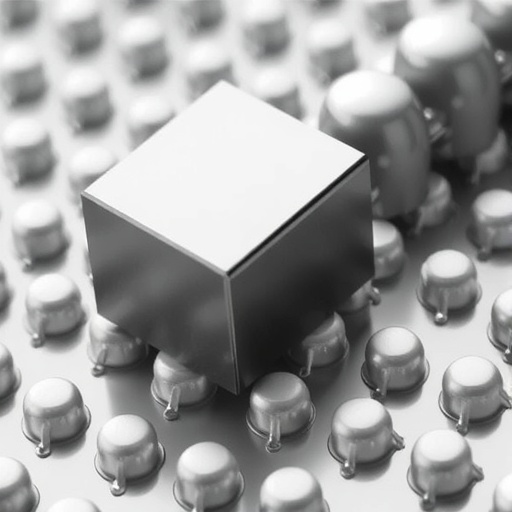In recent years, the pursuit of advanced energy storage systems has gained unprecedented momentum, driven by the need for sustainable and efficient solutions. Among the leading contenders in this field are hybrid supercapacitors, which combine the rapid charge-discharge capabilities of traditional supercapacitors with the high energy density of batteries. A significant breakthrough in this arena was recently reported by a research team exploring the structural and electrochemical modifications of CuNi₂O₄ spinel, a promising material for high-performance electrodes.
CuNi₂O₄ spinel is a complex oxide known for its unique structural and electrochemical properties. The research centered on optimizing these characteristics to enhance the performance metrics of hybrid supercapacitors. By systematically altering the composition and structural arrangement of CuNi₂O₄, the researchers aimed to improve charge storage efficiency and cycle stability, two critical factors in energy storage applications. Through a combination of experimental techniques and computational modeling, the team unveiled new insights into how modifications to the spinel structure can lead to superior performance.
The investigation involved synthesizing various compositions of CuNi₂O₄ through advanced techniques, ensuring precise control over the stoichiometry. The authors meticulously characterized the resultant materials, employing techniques such as X-ray diffraction, scanning electron microscopy, and electrochemical impedance spectroscopy. These analytical methods provided a detailed understanding of the structural attributes and allowed for real-time observation of the electrochemical behavior of the modified spinel oxides.
One of the most pivotal discoveries made during the research was the effect of incorporating different metal ions into the CuNi₂O₄ lattice. This fine-tuning allowed for the optimization of electronic conductivity, which is crucial for high-rate charge and discharge cycles. The results indicated that slight variations in metal incorporation could significantly impact the electrochemical performance, leading to higher capacitance values and improved energy density compared to standard configurations of the spinel.
Additionally, the research delved into the role of morphology in determining the electrochemical performance of CuNi₂O₄. The team found that controlling the particle size and distribution could further enhance the charge transport pathways, facilitating faster electron transfer during charging and discharging. This aspect of the study emphasized the interconnectedness of material design and performance, highlighting how strategic alterations can yield dramatic improvements in hybrid supercapacitor technology.
The advancements in CuNi₂O₄ not only promise heightened efficiency in energy storage but also address important sustainability considerations. With the global push towards greener technologies, the flexibility of this spinel material presents an attractive alternative to conventional energy storage solutions, many of which rely on rare or toxic elements. The research team underscored this potential by showcasing how their tailored CuNi₂O₄ formulations could lead to more environmentally friendly production processes, offering a viable pathway for industrial applications.
Furthermore, the durability of hybrid supercapacitors is a crucial factor in their overall viability. The team conducted extensive cycle stability tests on the various CuNi₂O₄ compositions, demonstrating remarkable retention of capacity even after thousands of charge-discharge cycles. Such longevity is essential for practical implementations in devices like electric vehicles and portable electronics, where reliability over time is paramount.
Moreover, to understand the charge storage mechanism at a deeper level, the research involved complex electrochemical modeling. These models simulated real-world applications, providing insights into how the modified CuNi₂O₄ behaves in actual operating environments. By merging experimental data with computational predictions, the researchers were able to validate their findings, ensuring the reliability of their proposed applications for these materials.
In summary, this groundbreaking research not only pioneers advancements in energy storage materials through the enhancement of CuNi₂O₄ spinel but also sets a precedent for future studies. The team’s comprehensive approach, integrating synthesis, characterization, and application modeling, showcases the potential for significant advancements in hybrid supercapacitor technology. As the energy landscape continues to evolve, the contributions from this study may well serve as a cornerstone for the next generation of efficient and sustainable energy storage solutions.
In conclusion, the impact of tailoring the structural and electrochemical properties of CuNi₂O₄ spinel is poised to resonate across multiple fields, from renewable energy to electric mobility. As researchers and industries increasingly gravitate towards innovative electrode materials, the work highlighted in this study offers valuable insights and inspiration for future endeavors in the energy sector. The path forward seems promising, bolstered by the scientific community’s unwavering commitment to uncovering and unlocking the potentials of materials that can lead to sustainable energy for generations to come.
Subject of Research: Structural and electrochemical properties of CuNi₂O₄ spinel for hybrid supercapacitors.
Article Title: Tailoring the structural and electrochemical properties of CuNi₂O₄ spinel for high-performance hybrid supercapacitor electrodes.
Article References:
K., A.D., S., K., K., K. et al. Tailoring the structural and electrochemical properties of CuNi₂O₄ spinel for high-performance hybrid supercapacitor electrodes. Ionics (2025). https://doi.org/10.1007/s11581-025-06638-x
Image Credits: AI Generated
DOI: https://doi.org/10.1007/s11581-025-06638-x
Keywords: CuNi₂O₄ spinel, hybrid supercapacitors, energy storage, electrochemical properties, sustainable technology, advanced materials, charge storage mechanisms, cycle stability, electric vehicles, renewable energy.




